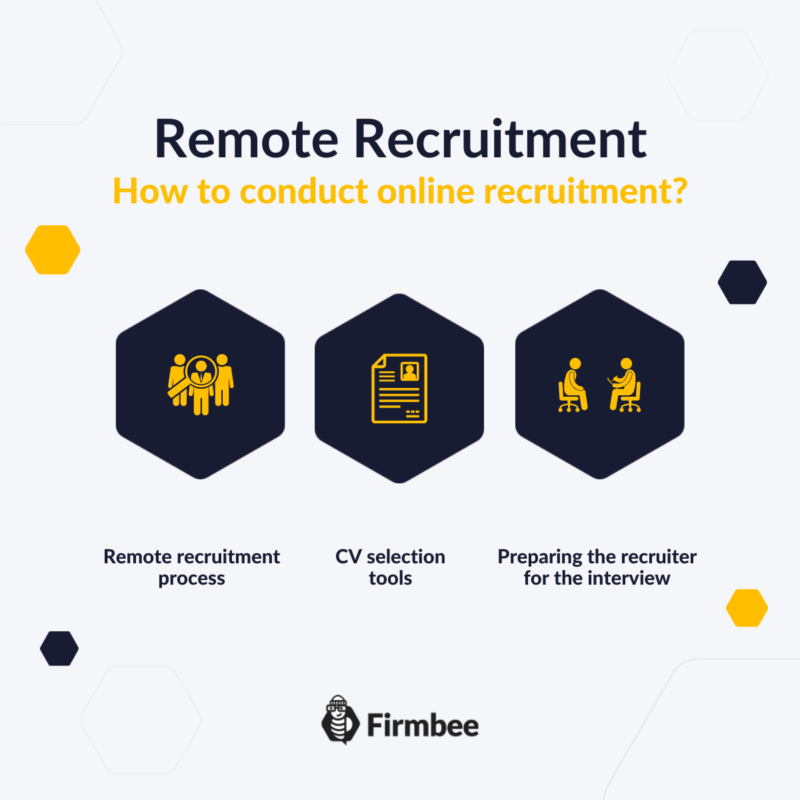The term remote recruitment refers to an interview with a candidate via phone or video call instead of meeting in person. Remote recruiting is not new, many companies have been using it for a long time. It may be a preliminary verification – the first stage of recruitment, to determine whether a given candidate is worth inviting for a proper recruitment interview at the company. However, in times of pandemic, more and more often the entire recruitment process is conducted remotely. In most companies, this is already a standard since it guarantees maximum safety for the recruiter and the candidate.
Remote recruitment – table of contents:
- CV selection tool
- Remote recruitment process
- Preparing the recruiter for the interview
- Check out our recruitment software for HR
The recruiter might find it challenging to get to know a person during such a remote interview – the accompanying stress and distance can influence a candidate’s behavior in a variety of different ways. Therefore, the first impression, which plays a large role in the decision to hire may prove to be wrong. There is also the technical side of this form of recruitment, which requires more preparation than a stationary interview: the right equipment, efficient Internet connection and tools to support the entire process.

CV selection tool
The first stage of recruitment is the preparation of an appropriate announcement and its publication. It should contain visible information about the remote mode of recruitment – for the convenience of the candidates. For many people, remote recruitment is still something new and unknown, therefore inform the candidate about it even before his application.
Pre-selection is considered by recruiters to be the most difficult and complex stage of the recruitment process. Taking care of software to monitor the progress of the recruitment and candidates. CV selection tools can also be useful. IT recruiters may find useful GlossaryTech or Mr. Toomuch, which during the verification of the candidate can help decipher the technical terminology incomprehensible to someone outside the industry. Also, worth mentioning is a free plug-in OctoHR, which efficiently and quickly filters the best candidates and summarizes the most important information about them. Other valuable tools that streamline the candidate sourcing process include Slack, CV Timeline, Hiretual, and Workable.
During this first stage, in addition to organizing your work, remember about the candidates applying and keeping them informed about the status of the application. In addition to tools for direct communication with candidates, consider chatbots that provide quick responses to questions and concerns of candidates. The main benefit for the recruiter here is saving time.
Remote recruitment process
After the initial selection of candidates it is time for the first phone contact, during which the recruiter obtains additional information about the candidate and with mutual willingness sets a convenient time for a phone or video interview. In the case of an online interview, the candidate should receive an invitation with a link to the meeting in advance – after clicking on it, he/she joins the meeting on the agreed date.
The most popular instant messengers used during recruitment interviews include Microsoft Teams, Zoom, and Google Hangouts – they are free in the basic version and work both on desktop and mobile devices. During the interview, the recruiter should gather information about the previous career, verify language skills and gauge the employee’s commitment. At the end of the interview, it’s a good idea to provide information about the deadline for the final decision.
Preparing the recruiter for the interview
Recruiter should properly prepare for an interview. In addition to a neat, presentable appearance, they should also take care of a uniform background without distractors, order, good lighting, and peace for the duration of the interview. It’s also a good idea to check the quality of the internet connection before the interview begins.
After assessing competencies and features required for a given position, a decision to hire is made and candidates are provided feedback. After completing the formalities necessary before employment, the recruiter’s responsibilities also include online onboarding, i.e. the remote deployment of the employee: familiarizing him/her with the company’s mission, vision, strategy and objectives, setting the date for occupational health and safety training and induction training.
The key to efficient online recruitment is the selection of appropriate software (which will also be available to the candidate), the use of technological tools, good organization and preparation for the entire process.
Check out our recruitment software for HR:
If you like our content, join us on Facebook or Twitter!
Author: Nicole Mankin
HR manager with an excellent ability to build a positive atmosphere and create a valuable environment for employees. She loves to see the potential of talented people and mobilize them to develop.
The most important questions
-
Why is remote recruiting challenging for a recruiter?
In addition to the substantive part of the meeting, you must also prepare the technical side, learn about the tools and messengers that facilitate remote recruitment, and take care of a quiet place with good lighting and an efficient Internet connection.
-
Which instant messengers to use during a remote recruitment interview?
Some of the most popular instant messengers include Microsoft Teams, Zoom, and Google Hangouts – they’re free to use in the basic version and work on both desktop and mobile devices.
-
What is online onboarding?
Online onboarding is a remote employee induction: familiarizing the employee with the company’s mission, vision, strategy and goals by scheduling health and safety training and induction training.


















